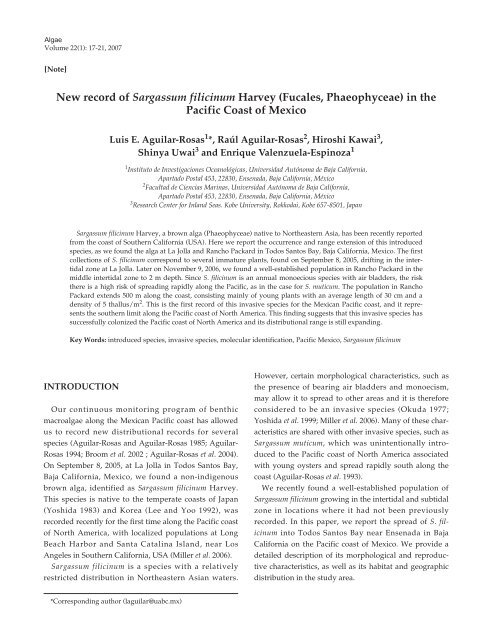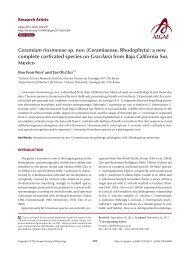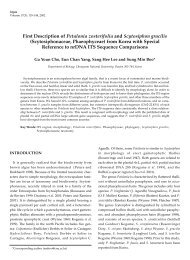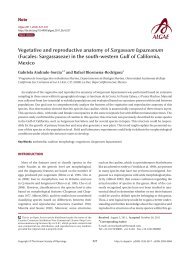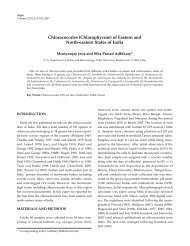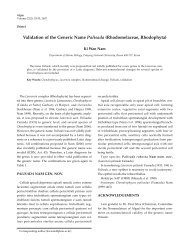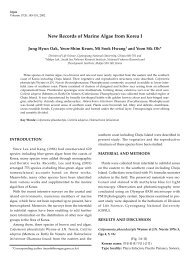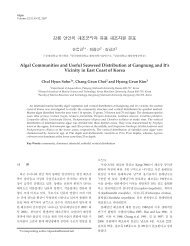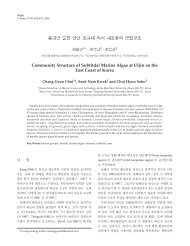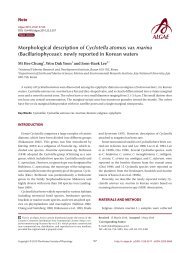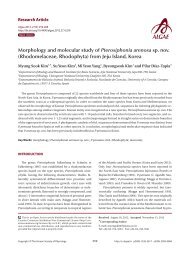New record of Sargassum filicinum Harvey (Fucales ... - Algae
New record of Sargassum filicinum Harvey (Fucales ... - Algae
New record of Sargassum filicinum Harvey (Fucales ... - Algae
Create successful ePaper yourself
Turn your PDF publications into a flip-book with our unique Google optimized e-Paper software.
<strong>Algae</strong><br />
Volume 22(1): 17-21, 2007<br />
[Note]<br />
<strong>New</strong> <strong>record</strong> <strong>of</strong> <strong>Sargassum</strong> <strong>filicinum</strong> <strong>Harvey</strong> (<strong>Fucales</strong>, Phaeophyceae) in the<br />
Pacific Coast <strong>of</strong> Mexico<br />
INTRODUCTION<br />
Luis E. Aguilar-Rosas 1 *, Raúl Aguilar-Rosas 2 , Hiroshi Kawai 3 ,<br />
Shinya Uwai 3 and Enrique Valenzuela-Espinoza 1<br />
1 Instituto de Investigaciones Oceanológicas, Universidad Autónoma de Baja California,<br />
Apartado Postal 453, 22830, Ensenada, Baja California, México<br />
2 Facultad de Ciencias Marinas, Universidad Autónoma de Baja California,<br />
Apartado Postal 453, 22830, Ensenada, Baja California, México<br />
3 Research Center for Inland Seas. Kobe University, Rokkodai, Kobe 657-8501, Japan<br />
<strong>Sargassum</strong> <strong>filicinum</strong> <strong>Harvey</strong>, a brown alga (Phaeophyceae) native to Northeastern Asia, has been recently reported<br />
from the coast <strong>of</strong> Southern California (USA). Here we report the occurrence and range extension <strong>of</strong> this introduced<br />
species, as we found the alga at La Jolla and Rancho Packard in Todos Santos Bay, Baja California, Mexico. The first<br />
collections <strong>of</strong> S. <strong>filicinum</strong> correspond to several immature plants, found on September 8, 2005, drifting in the intertidal<br />
zone at La Jolla. Later on November 9, 2006, we found a well-established population in Rancho Packard in the<br />
middle intertidal zone to 2 m depth. Since S. <strong>filicinum</strong> is an annual monoecious species with air bladders, the risk<br />
there is a high risk <strong>of</strong> spreading rapidly along the Pacific, as in the case for S. muticum. The population in Rancho<br />
Packard extends 500 m along the coast, consisting mainly <strong>of</strong> young plants with an average length <strong>of</strong> 30 cm and a<br />
density <strong>of</strong> 5 thallus/m 2 . This is the first <strong>record</strong> <strong>of</strong> this invasive species for the Mexican Pacific coast, and it represents<br />
the southern limit along the Pacific coast <strong>of</strong> North America. This finding suggests that this invasive species has<br />
successfully colonized the Pacific coast <strong>of</strong> North America and its distributional range is still expanding.<br />
Key Words: introduced species, invasive species, molecular identification, Pacific Mexico, <strong>Sargassum</strong> <strong>filicinum</strong><br />
Our continuous monitoring program <strong>of</strong> benthic<br />
macroalgae along the Mexican Pacific coast has allowed<br />
us to <strong>record</strong> new distributional <strong>record</strong>s for several<br />
species (Aguilar-Rosas and Aguilar-Rosas 1985; Aguilar-<br />
Rosas 1994; Broom et al. 2002 ; Aguilar-Rosas et al. 2004).<br />
On September 8, 2005, at La Jolla in Todos Santos Bay,<br />
Baja California, Mexico, we found a non-indigenous<br />
brown alga, identified as <strong>Sargassum</strong> <strong>filicinum</strong> <strong>Harvey</strong>.<br />
This species is native to the temperate coasts <strong>of</strong> Japan<br />
(Yoshida 1983) and Korea (Lee and Yoo 1992), was<br />
<strong>record</strong>ed recently for the first time along the Pacific coast<br />
<strong>of</strong> North America, with localized populations at Long<br />
Beach Harbor and Santa Catalina Island, near Los<br />
Angeles in Southern California, USA (Miller et al. 2006).<br />
<strong>Sargassum</strong> <strong>filicinum</strong> is a species with a relatively<br />
restricted distribution in Northeastern Asian waters.<br />
*Corresponding author (laguilar@uabc.mx)<br />
However, certain morphological characteristics, such as<br />
the presence <strong>of</strong> bearing air bladders and monoecism,<br />
may allow it to spread to other areas and it is therefore<br />
considered to be an invasive species (Okuda 1977;<br />
Yoshida et al. 1999; Miller et al. 2006). Many <strong>of</strong> these characteristics<br />
are shared with other invasive species, such as<br />
<strong>Sargassum</strong> muticum, which was unintentionally introduced<br />
to the Pacific coast <strong>of</strong> North America associated<br />
with young oysters and spread rapidly south along the<br />
coast (Aguilar-Rosas et al. 1993).<br />
We recently found a well-established population <strong>of</strong><br />
<strong>Sargassum</strong> <strong>filicinum</strong> growing in the intertidal and subtidal<br />
zone in locations where it had not been previously<br />
<strong>record</strong>ed. In this paper, we report the spread <strong>of</strong> S. <strong>filicinum</strong><br />
into Todos Santos Bay near Ensenada in Baja<br />
California on the Pacific coast <strong>of</strong> Mexico. We provide a<br />
detailed description <strong>of</strong> its morphological and reproductive<br />
characteristics, as well as its habitat and geographic<br />
distribution in the study area.
18 <strong>Algae</strong> Vol. 22(1), 2007<br />
MATERIALS AND METHODS<br />
The first specimens <strong>of</strong> <strong>Sargassum</strong> <strong>filicinum</strong> were<br />
observed and collected on September 8, 2005, and collected<br />
drifting in the intertidal zone at La Jolla in Todos<br />
Santos Bay, Baja California, Mexico (31° 43’ 17” N and<br />
116° 40’ 17” W) (Fig. 1). We conducted several subsequent<br />
samplings trips along the Pacific Coast <strong>of</strong> Baja<br />
California including Todos Santos Bay, and discovered a<br />
well established population <strong>of</strong> S. <strong>filicinum</strong> in Rancho<br />
Packard in Todos Santos Bay, Baja California, Mexico on<br />
October 8, 2006 (31° 46’ 09” N and 116° 41’ 54” W). Plants<br />
were collected from the rocky intertidal and subtidal<br />
zone. Collections were placed in plastic bags and transported<br />
to the laboratory for immediate analysis. They<br />
were then fixed with 4% formalin seawater solution and<br />
mounted on herbarium sheets. A collection <strong>of</strong> specimens<br />
are deposited in the herbarium CMMEX <strong>of</strong> the Facultad<br />
de Ciencias Marinas from the Universidad Autónoma de<br />
Baja California (UABC) (CMMEX 4439, 4440, 4441, 4442,<br />
4443, 4444) (Holmgren et al. 1985) and in the herbarium<br />
the University <strong>of</strong> California, Berkeley, California, USA<br />
(UC 1862395, 1862396, 1862397).<br />
Observations were conducted using Zeiss Axioscope<br />
40 microsope (Göttingen, Germany). Photographs <strong>of</strong> sections<br />
were taken on a with a Sony DSC-S85 digital camera<br />
(Tokyo, Japan). For species identifications, we compared<br />
our specimens with descriptions and illustrations<br />
<strong>of</strong> <strong>Sargassum</strong> <strong>filicinum</strong> in Chihara (1975), Miller et al.<br />
(2006) and with Japanese and California specimens. To<br />
confirm our morphological identification, the mitochondria<br />
cytochrome oxidase subunit III gene (cox3) was<br />
sequenced and compared with the reported sequence <strong>of</strong><br />
the species from Japan and California (Miller et al. 2006).<br />
RESULTS AND DISCUSSION<br />
Distribution<br />
The first collections <strong>of</strong> <strong>Sargassum</strong> <strong>filicinum</strong> along the<br />
coast <strong>of</strong> the Mexican Pacific were several immature<br />
plants, found on September 8, 2005, drifting in the intertidal<br />
zone at La Jolla. Later, on November 9, 2006 we<br />
found another population well established in Rancho<br />
Packard in the middle intertidal zone to 2 m depth in<br />
Todos Santos Bay, Baja California, Mexico.<br />
Since the first specimens <strong>of</strong> S. <strong>filicinum</strong> along the<br />
Pacific coast <strong>of</strong> North America were found at Santa<br />
Catalina Island in Southern California (USA) in October<br />
Fig. 1. Map showing the study site and collections sites.<br />
2003 (northern limit) (Miller et al. 2006), our collections<br />
represent the first <strong>record</strong> <strong>of</strong> this invasive species in the<br />
Mexican Pacific. In addition, these findings extend the<br />
southern limit <strong>of</strong> S. <strong>filicinum</strong> in North America by about<br />
300 Km, from Santa Catalina Island to La Jolla and<br />
Rancho Packard in Todos Santos Bay, Mexico (Fig. 1).<br />
These findings suggest that the range <strong>of</strong> S. <strong>filicinum</strong> is<br />
still expanding along the Pacific coast <strong>of</strong> North America<br />
(including into Mexico). We suggest that dispersal will<br />
continue and that this species will colonize new localities,<br />
because habitats and environmental conditions in<br />
North America are similar to those in its native range. A<br />
similar pattern occurred when S. muticum when this<br />
Japanese species was introduced to the Pacific coast <strong>of</strong><br />
North America in the 1940’s (Scagel 1956; Nicholson<br />
1979), and it is now <strong>record</strong>ed as far south as Guadalupe,<br />
Baja California Sur, Mexico (Aguilar-Rosas and Aguilar-<br />
Rosas 1993).<br />
Habitat<br />
<strong>Sargassum</strong> <strong>filicinum</strong> is found growing on rocks from the<br />
intertidal into the shallow subtidal to a depth <strong>of</strong> 6 m. In<br />
the intertidal zone it is found associated with Lithothrix<br />
aspergillum, Corallina vancouveriensis, <strong>Sargassum</strong> muticum,<br />
S. agardhianum, S. palmeri, Dictyopteris undulata and<br />
Dictyota flabellata. The studied population is found along<br />
500 m in the protected coast <strong>of</strong> Rancho Packard in Todos
Santos Bay, at a density approximately 5 thallus/m 2 .<br />
Morphology, molecular identification and reproduction<br />
The population <strong>of</strong> S. <strong>filicinum</strong> in the study area is<br />
mainly composed <strong>of</strong> young plants with an average<br />
height <strong>of</strong> 30 cm, but some fertile adult individuals with<br />
an average height <strong>of</strong> 80 cm are present. The erect thallus<br />
is medium brown to brown arising from a solid and<br />
rugose discoid holdfast having a spiny terete stipe bearing<br />
alternate spiny branches with deeply incised, <strong>of</strong>ten<br />
notched vegetative leaves (Fig. 2). The principal characteristic<br />
for identifying this species is by the form <strong>of</strong> the<br />
air bladders (pneumatocysts) which are spherical to<br />
elliptical (Fig. 2), while those <strong>of</strong> other species present in<br />
this area are spherical like S. muticum, S. palmeri and S.<br />
agardhianum (Abbott and Hollenberg, 1976). Miller et al.<br />
(2006) compared S. <strong>filicinum</strong> with a related Japanese<br />
Aguilar-Rosas et al.: <strong>New</strong> <strong>record</strong> <strong>of</strong> <strong>Sargassum</strong> <strong>filicinum</strong> <strong>Harvey</strong> 19<br />
Fig. 2. <strong>Sargassum</strong> <strong>filicinum</strong> <strong>Harvey</strong>. a. Specimen collected on November 9, 2006 in Rancho Packard at Todos Santos Bay, Baja<br />
California. Mexico. Scale = 5 cm. b. Spiny terete stype, bearing alternate spiny branches with notched vegetative leaves. Scale = 1<br />
cm. c. Detail <strong>of</strong> the spherical/elliptical air bladders. Scale = 1 cm. d. Discoid holdfast having the very spiny stipe. Scale = 1 cm.<br />
species S. horneri that has a considerably similar morphology,<br />
but S. horneri bears cylindrical air bladders.<br />
When the plant is mature, it forms receptacles 4 cm long,<br />
which appear as cigar-shape.<br />
We utilized a 469 bp sequence <strong>of</strong> the mitochondrial<br />
cox3 gene in the Baja California specimen and compared<br />
it to specimens collected in the Seto inland Sea, Japan<br />
and St. Catalina Island, CA. All <strong>of</strong> S. <strong>filicinum</strong> specimens<br />
examined had the same mitochondrial cox3 sequence<br />
(accession number AB264797). A faster evolving gene is<br />
needed to determine the source <strong>of</strong> the introductions and<br />
examine the relationship between populations.<br />
Introduction vector<br />
The introduction <strong>of</strong> S. <strong>filicinum</strong> into the coast <strong>of</strong> Baja<br />
California may be correlated with the traffic <strong>of</strong> commercial<br />
vessels (including large Asiatic cargo ships) and<br />
tourist cruise ships visiting Ensenada harbor from
20 <strong>Algae</strong> Vol. 22(1), 2007<br />
Southern California (Casarrubias-Garcia 2001). Todos<br />
Santos Bay is also a destination for recreational boats<br />
(sailing yachts, etc.) coming from Southern California<br />
and are considered to be potential vector for the introduction<br />
<strong>of</strong> marine species (Ribera and Boudouresque,<br />
1995).<br />
The introduction <strong>of</strong> S. <strong>filicinum</strong> in Todos Santos Bay<br />
may resulted from plants attached to ship’ hulls, and/or<br />
from spores or embryos carried in ships’ ballast water<br />
(Critchley et al. 1990; Piriz and Casas 1994; Forrest et al.<br />
2000). It is also possible that since S. <strong>filicinum</strong> has pneumatocysts,<br />
it drifted south from Southern California on<br />
the California current (Fig. 1). Regardless <strong>of</strong> the mode <strong>of</strong><br />
introduction, we are confident that S. <strong>filicinum</strong> is a recent<br />
introduction; two years ago we conducted surveys and<br />
made collections in the area around Rancho Packard and<br />
S. <strong>filicinum</strong> was not present.<br />
The first specimens <strong>of</strong> S. <strong>filicinum</strong> along the Pacific<br />
coast <strong>of</strong> North America were found at Santa Catalina<br />
Island in Southern California (USA) on October 2003<br />
(northern limit) (Miller et al. 2006); it is considered a<br />
highly invasive species, like S. muticum (Norton 1981)<br />
and Undaria pinnatifida (Forrest et al. 2000; Silva et al.<br />
2002). It is well adapted for widespread dispersal and<br />
rapid colonization (Nyberg and Walentinius 2005), with<br />
morphological and reproductive characteristics, such as<br />
buoyancy and high reproductive output, which allow it<br />
to invade and establish successfully in new areas (Miller<br />
et al. 2006). Silva et al. (2002) suggest that eradication<br />
efforts <strong>of</strong> introduced species <strong>of</strong> macroalgae can be successful<br />
when the introduction is detected at an early<br />
stage (before spore release) and confined to a small area.<br />
As an example, Caulerpa taxifolia was introduced in 2000<br />
and declared eradicated in 2005 (Merkel and Associates,<br />
2005).<br />
The discovery <strong>of</strong> these introduced macroalgal species<br />
in the Mexican Pacific coast is part <strong>of</strong> a continuous monitoring<br />
program at our University, and S. <strong>filicinum</strong> is now<br />
added to the list <strong>of</strong> introduced macroalgae in this region.<br />
Other well-documented introductions are S. muticum<br />
(Aguilar-Rosas and Aguilar-Rosas 1985; 1993), Lomentaria<br />
hakodatensis (Dawson 1944), Cutleria cylindrica (Aguilar-<br />
Rosas 1994), Porphyra suborbiculata (Broom et al. 2002;<br />
Aguilar-Rosas and Aguilar-Rosas 2003), Undaria pinnatifida<br />
(Aguilar-Rosas et al. 2004).<br />
Ecological impact<br />
It important to document these new findings, as well<br />
as the spread <strong>of</strong> the additional introduced species. The<br />
recent introduction and establishment <strong>of</strong> <strong>Sargassum</strong> <strong>filicinum</strong><br />
in Mexico will require attention, since there may<br />
be some negative ecological effects <strong>of</strong> this species. More<br />
ecological studies <strong>of</strong> S. <strong>filicinum</strong> and detailed surveys <strong>of</strong><br />
their habitat requirements are needed to better determine<br />
the possible ecological impact <strong>of</strong> this invader on coastal<br />
communities.<br />
ACKNOWLEDGMENTS<br />
This work was supported by Institute <strong>of</strong><br />
Oceanographic Research and Faculty <strong>of</strong> Marine Science<br />
<strong>of</strong> the Universidad Autonoma de Baja California, under<br />
the Program No 571 (10 a UABC Research program PIAC-<br />
CEC) and the monitoring program <strong>of</strong> Herbarium<br />
CMMEX. We thank Filiberto Núñez-Cebrero for assistance<br />
in the field and laboratory. Special thanks to<br />
Benjamin Ruttenberg for the English translation.<br />
REFERENCES<br />
Abbott, I.A. and Hollenberg, G.J. 1976. Marine <strong>Algae</strong> <strong>of</strong> California.<br />
Stanford University Press, Stanford California.<br />
Aguilar-Rosas R. 1994. Notas ficológicas. I. Primer registro de<br />
Cutleria cylindrica Okamura (Cutleriaceae, Phaeophyta)<br />
para las costas del Pacífico mexicano. Acta Botánica<br />
Mexicana 29: 55-60.<br />
Aguilar-Rosas R. and Aguilar-Rosas L.E. 1985. <strong>Sargassum</strong><br />
muticum (Yendo) Fensholt (<strong>Fucales</strong>, Phaeophyta) en las<br />
costas de Baja California, México. Ciencias Marinas 11: 127-<br />
129.<br />
Aguilar-Rosas R. and Aguilar-Rosas L.E. 1993. Cronología de la<br />
colonización de <strong>Sargassum</strong> muticum (Phaeophyta) en las<br />
costas de la península de Baja California, México (1971-<br />
1990). Revista de Investigación Científica 4: 41-51.<br />
Aguilar-Rosas R., Aguilar-Rosas L.E., Ávila-Serrano G. and<br />
Marcos-Ramírez R. 2004. First <strong>record</strong> <strong>of</strong> Undaria pinnatifida<br />
(<strong>Harvey</strong>) Suringar (Lamiariales, Phaeophyta on the Pacific<br />
coast <strong>of</strong> Mexico. Bot. Mar. 47: 255-258.<br />
Aguilar-Rosas R. and Aguilar-Rosas L.E. 2003. El género<br />
Porphyra (Bangiaceae, Rhodophyta) en la costa Pacífico de<br />
México. I. Porphyra suborbiculata Kjellman. Hidrobiológica 13:<br />
51-56.<br />
Broom, J.E., Nelson W.A., Yarish C., Jones W.A., Aguilar-Rosas<br />
R. and Aguilar-Rosas L.E. 2002. A reassessment <strong>of</strong> the taxonomic<br />
status <strong>of</strong> Porphyra suborbiculata, Porphyra carolinensis<br />
and Porphyra liliputiana (Bangiales, Rhodophyta) based on<br />
molecular and morphological data. Eur. J. Phycol. 37: 227-<br />
23.<br />
Casarrubias-García A. 2001. Puertos, potencialidades y auge de<br />
los cruceros. Mexicoa 3: 102-111.<br />
Chihara M. 1975. Picture Book <strong>of</strong> Seaweeds. Gakken Co. Ltd,.<br />
Tokyo.
Critchley A.T., Farnham W.F., Yoshida T. and Norton T.A. 1990.<br />
A biogeography <strong>of</strong> the invasive alga <strong>Sargassum</strong> muticum<br />
(Yendo) Fensholt (<strong>Fucales</strong>, Sargassaceae). Bot. Mar. 33: 551-<br />
562.<br />
Dawson E.Y. 1944. The marine algae <strong>of</strong> the Gulf <strong>of</strong> California.<br />
Allan Hancock Pacific Expedition 3: 189-454.<br />
Espinoza J. 1990. The southern limit <strong>of</strong> <strong>Sargassum</strong> muticum<br />
(Yendo) Fensholt (Phaeophyta, <strong>Fucales</strong>) in the Mexican<br />
Pacific. Bot. Mar. 33: 193-196.<br />
Forrest B.M., Brown S.N., Taylor M.D., Hurd C.L. and Hay C.H.<br />
2000. The role <strong>of</strong> natural dispersal mechanisms in the<br />
spread <strong>of</strong> Undaria pinnatifida (Laminariales, Phaeophyceae).<br />
Phycologia 39: 547-553<br />
Holmgren P.K. 1985. Additions to Index Herbariorum, Part I.<br />
The Herbaria <strong>of</strong> the World, Edition 7 (III). Taxon 34: 735-<br />
738.<br />
Lee I.K. and Yoo S.-A. 1992. Korean species <strong>of</strong> <strong>Sargassum</strong> subgenus<br />
Bactrophycus J. Agardh (Sargassaceae, <strong>Fucales</strong>). In:<br />
Abbott I.A. (ed.), Taxonomy <strong>of</strong> Economic Seaweeds. Vol 3.<br />
California Sea Grant Collage, La Jolla, California, pp. 134-<br />
147.<br />
Merkel and Associates 2005. Eradication and surveillance <strong>of</strong><br />
Caulerpa taxifolia within Agua Hedionda Lagoon, Carlsbad,<br />
California. Fourth Year Status Report. Report prepared for<br />
Southern California Caulerpa Action Team. 12 pp.<br />
Miller K.A., Engle J.M., Uwai S. and Kawai H. 2006. First report<br />
<strong>of</strong> the Asian seaweed <strong>Sargassum</strong> <strong>filicinum</strong> (<strong>Fucales</strong>) in<br />
California, USA. Biological Invasions (in press).<br />
Nicholson N.L. 1979. <strong>Sargassum</strong> muticum: a Japanese seaweed<br />
continues moving into new waters. 2 nd National Coastal<br />
Aguilar-Rosas et al.: <strong>New</strong> <strong>record</strong> <strong>of</strong> <strong>Sargassum</strong> <strong>filicinum</strong> <strong>Harvey</strong> 21<br />
Shallow Washington Research Conference 167.<br />
Norton T.A. 1981. <strong>Sargassum</strong> muticum on the Pacific coast <strong>of</strong><br />
North America. Proceedings <strong>of</strong> the International Seaweed<br />
Symposium 8: 449-456.<br />
Nyberg C.D. and Wallentinus I. 2005. Can species traits be used<br />
to predict marine macroalgal introduction? Biological<br />
Invasions 7: 265-279.<br />
Piriz M.L. and Casas G. 1994. Occurrence <strong>of</strong> Undaria pinnatifida<br />
in Golfo Nuevo, Argentina. Applied Phycology Forum 10: 4.<br />
Ribera M.A. and Boudouresque C.F. 1995. Introduced marine<br />
plants, with special reference to macroalgae: mechanisms<br />
and impact. Progress in Phycological Research 11: 187-268.<br />
Scagel R.F. 1956. Introduction <strong>of</strong> a Japanese alga <strong>Sargassum</strong><br />
muticum into the northeast Pacific. Fisheries Research Paper<br />
St. Washington 1: 49-58.<br />
Silva P.C., Woodfield R.A., Cohen A.N., Harris L.H. and<br />
Goddard J.H.R. 2002. First report <strong>of</strong> the Asian kelp Undaria<br />
pinnatifida in the Northeastern Pacific Ocean. Biological<br />
Invasions 4: 333-338.<br />
Yoshida G., Murase N and Terawaki T. 1999. Comparisons <strong>of</strong><br />
germling growth abilities under various culture conditions<br />
among two <strong>Sargassum</strong> horneri populations and S. <strong>filicinum</strong><br />
in Hiroshima Bay. Bulletin <strong>of</strong> Fisheries and Environment <strong>of</strong><br />
Inland Sea 1: 45-54.<br />
Yoshida T. 1983. Japanese species <strong>of</strong> <strong>Sargassum</strong> subgenus<br />
Bactrophycus (Phaeophyta, <strong>Fucales</strong>). Journal <strong>of</strong> the Faculty <strong>of</strong><br />
Science. Hokkaido Univ. Ser. V. 13: 99-246.<br />
Received 1 February 2007<br />
Accepted 27 February 2007


